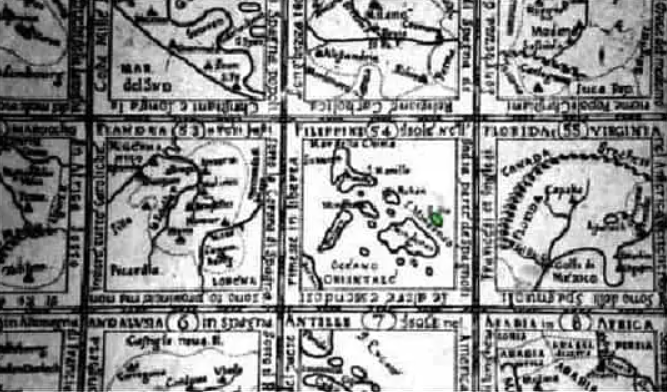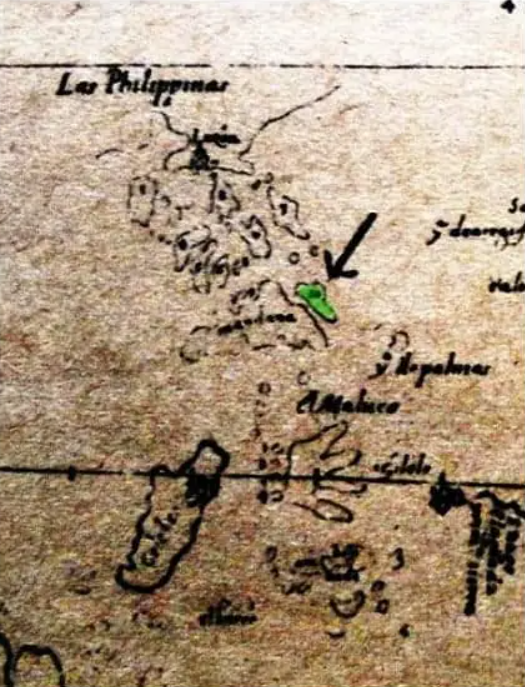
The story of the long lost island of San Juan is as big a mystery as most any other local legend. Our fascination with it is reminiscent of the world's curiosity with the city of Atlantis. The only difference is that this supposed land off the northeastern tip of Mindanao has appeared in maps dating back to the 16th- to 18th-centuries by some of the world's leading cartographers at the time.
It would eventually vanish and become one of our most intriguing geographical anomalies. Today, it has transcended academic discourse and made its way to the annals of obscure Filipino lore. But the question remains: did San Juan Island really exist? And if so, how did it manage to slip through the hands of mapmakers?
The island was first identified as a town in Cebu by Flemish cartographer Abraham Ortelius back in 1570. In Asiae Nova Descriptio, we can see what appears to be a place called "Ilhas de S. Johan." This record checks out with the Portuguese's, who had labeled the area as the island of San: Joa in a 1537 portolan chart we can credit to cartographer Gaspar Vargas.
Ilhas de S. Johan was eventually considered a separate island from Cebu in 1575, later to be validated by Antonio de Herrera y Tordesillas in the 1601 map Historia General de los Hechos de Los Castellanos en las Islas y Tierra Firme del Mar Oceano, which was printed in Madrid, Spain. According to early accounts, the island of San Juan was said to be larger than Bohol and might have even been as big as Panay Island, and was a separate entity from mainland Mindanao.
Bellin's map of the Philippines

The Dell’Arcano del Mare, a 17th-century maritime encyclopedia that was published in Florence, Italy from 1646, also featured the island. French cartographer Jacques-Nicolas Bellin also recorded the existence of the island back in 1750. British Royal Naval Officer Christopher Middleton even did a deep dive on the island of San Juan in A New and Complete System of Geography. Here, there were even descriptions of the island's inhabitants: they were said to have been more than the average Filipino height at the time (roughly five feet and two inches tall) and had curly black hair.
All these maps validated the area's existence and coordinates. The island would last be heard of on an 18th-century map by Herman Moll, and then mysteriously disappear.
One of the plates in A New and Complete System of Geography that allegedly featured the inhabitants of San Juan

Interestingly, in 1665, Antonio Pucini created this cartographic board game that was said to have "solved" the mystery of San Juan, as well. In this game of squares, tokens were slid to reach Venice and one of the squares featured the Philippines. Here, San Juan was replaced as San Sio (San Siargao).
The cartographic board game developed by Antonio Pucini

There are conflicting, more credible reports to consider, too, especially coming from our own researchers. If we check with our own ancient maps, like that of Jesuit cartographer Murillo Velarde's, the island of San Juan is nowhere to be found. In 1734, Velarde and his group came up with the Carta Hydrographica y Chorographica de las Islas Filipinas, which is considered by many as the "first and most important scientific map of the Philippines." Researchers call it the "Mother of all Philippine maps" for a reason. It is the same map we use for our claims to the Scarborough Shoal dispute, as well.
The island's legend persisted during the middle of the 20th century, so much so that it caught the attention of National Artist for Visual Arts and antique map collector Federico Aguilar Alcuaz back in 1969. Alcuaz claimed that the alleged island of San Juan had simply been a victim of natural disasters, much like the supposed city of Atlantis. This, of course, was heavily disputed, mostly by other historians, writers, and cartographers. The argument against this theory was that, how could this have not been recorded by scholars?
Carlos Quirino, the acclaimed Filipino historian, also claimed in the second edition of Philippine Cartography that it was simply just a fictionalized island that had been drawn in 1601; it was a mistake that would have quite the effect on the world's geographical understanding of the Philippines for a good 200 years.
The said Herrera Map released in 1601

The story of the long lost island of San Juan is as big a mystery as most any other local legend. Our fascination with it is reminiscent of the world's curiosity with the city of Atlantis. The only difference is that this supposed land off the northeastern tip of Mindanao has appeared in maps dating back to the 16th- to 18th-centuries by some of the world's leading cartographers at the time.
It would eventually vanish and become one of our most intriguing geographical anomalies. Today, it has transcended academic discourse and made its way to the annals of obscure Filipino lore. But the question remains: did San Juan Island really exist? And if so, how did it manage to slip through the hands of mapmakers?
The island was first identified as a town in Cebu by Flemish cartographer Abraham Ortelius back in 1570. In Asiae Nova Descriptio, we can see what appears to be a place called "Ilhas de S. Johan." This record checks out with the Portuguese's, who had labeled the area as the island of San: Joa in a 1537 portolan chart we can credit to cartographer Gaspar Vargas.
Ilhas de S. Johan was eventually considered a separate island from Cebu in 1575, later to be validated by Antonio de Herrera y Tordesillas in the 1601 map Historia General de los Hechos de Los Castellanos en las Islas y Tierra Firme del Mar Oceano, which was printed in Madrid, Spain. According to early accounts, the island of San Juan was said to be larger than Bohol and might have even been as big as Panay Island, and was a separate entity from mainland Mindanao.
Bellin's map of the Philippines

The Dell’Arcano del Mare, a 17th-century maritime encyclopedia that was published in Florence, Italy from 1646, also featured the island. French cartographer Jacques-Nicolas Bellin also recorded the existence of the island back in 1750. British Royal Naval Officer Christopher Middleton even did a deep dive on the island of San Juan in A New and Complete System of Geography. Here, there were even descriptions of the island's inhabitants: they were said to have been more than the average Filipino height at the time (roughly five feet and two inches tall) and had curly black hair.
All these maps validated the area's existence and coordinates. The island would last be heard of on an 18th-century map by Herman Moll, and then mysteriously disappear.
One of the plates in A New and Complete System of Geography that allegedly featured the inhabitants of San Juan

ALSO READ:
How the Americans Double-Crossed the Last Sultan of Sulu
The Story Behind This Ancient Sulu Sultan's 600-Year-Old Tomb in China
Interestingly, in 1665, Antonio Pucini created this cartographic board game that was said to have "solved" the mystery of San Juan, as well. In this game of squares, tokens were slid to reach Venice and one of the squares featured the Philippines. Here, San Juan was replaced as San Sio (San Siargao).
The cartographic board game developed by Antonio Pucini

There are conflicting, more credible reports to consider, too, especially coming from our own researchers. If we check with our own ancient maps, like that of Jesuit cartographer Murillo Velarde's, the island of San Juan is nowhere to be found. In 1734, Velarde and his group came up with the Carta Hydrographica y Chorographica de las Islas Filipinas, which is considered by many as the "first and most important scientific map of the Philippines." Researchers call it the "Mother of all Philippine maps" for a reason. It is the same map we use for our claims to the Scarborough Shoal dispute, as well.
The island's legend persisted during the middle of the 20th century, so much so that it caught the attention of National Artist for Visual Arts and antique map collector Federico Aguilar Alcuaz back in 1969. Alcuaz claimed that the alleged island of San Juan had simply been a victim of natural disasters, much like the supposed city of Atlantis. This, of course, was heavily disputed, mostly by other historians, writers, and cartographers. The argument against this theory was that, how could this have not been recorded by scholars?
Carlos Quirino, the acclaimed Filipino historian, also claimed in the second edition of Philippine Cartography that it was simply just a fictionalized island that had been drawn in 1601; it was a mistake that would have quite the effect on the world's geographical understanding of the Philippines for a good 200 years.
The said Herrera Map released in 1601

All those coincidences by ancient scholars may have well been just an error made by mapmakers during the colonial era. It could be that it was a gross misrepresentation of what today could well be Siargao or the Micronesian island groups Palau and Sonsorol (Sonsorol's position is consistent with San Juan's at a latitude of about 5-6º north), based on earlier geographic details.
This story is a snapshot of how the West viewed the Philippine islands at the time. As Filipinos, there's always that part of us that wants this island to exist, and that's not necessarily a bad thing. The island of San Juan is, nevertheless, an interesting case study of how the best researchers are still prone to biases and mistakes.
Couple that with a prevailing colonial lens, and it can be a recipe for geographical confusion and historical distortion. It doesn't take away from their credibility, of course. These things happen and our perspectives should change and evolve with new information presented to us. At the very least, this mystery has now been transformed into the stuff of legends. These tall tales, at the end of the day, can actually say a lot more about our local history, identity, and culture than we realize.
Sources: